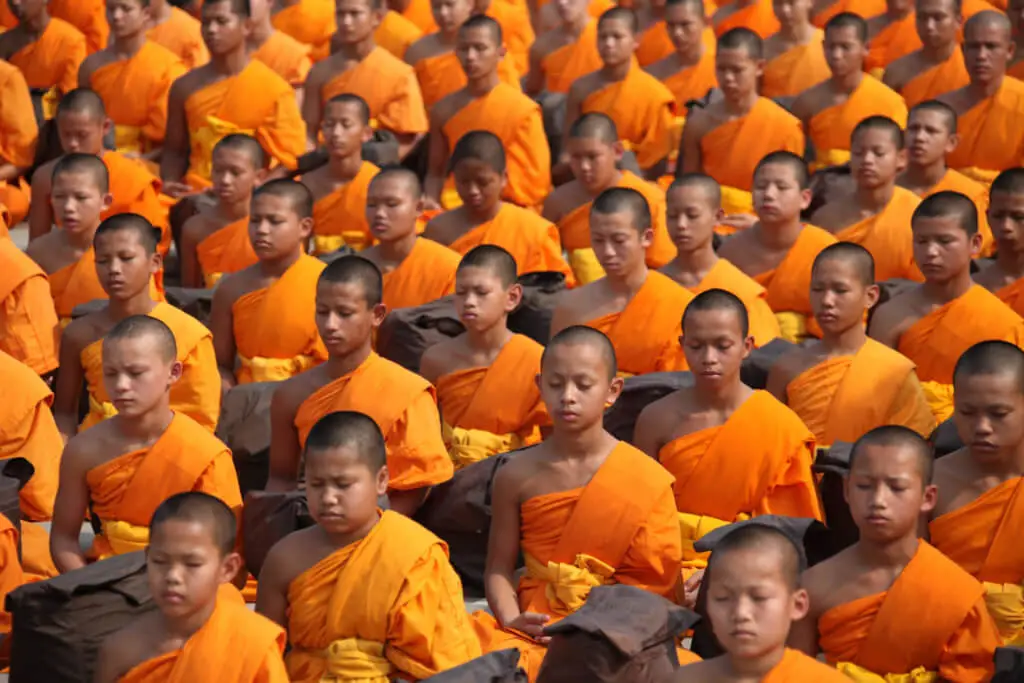Most estimates suggest that almost 233 million people worldwide hold to some form of Buddhism. If true, that means 3.3 percent of the world’s population is Buddhist. Yet for many of us, Buddhism remains relatively unknown. Many understand it as little more than a distant, peaceful religion held by Asians in faraway lands. The truth, though, is that Buddhism is one of the world’s fastest growing religions. Its numerical growth and cultural influence increase exponentially every year. So what is Buddhism? How should we understand it?
Defining Buddhism is difficult. To get a proper definition, you would need to decide between Mahayana Buddhism and Theravada Buddhism, East Asian Buddhism and Southeast Asian Buddhism, Cambodian Buddhism and Burmese Buddhism, city Buddhism and village Buddhism, historical Buddhism and modern Buddhism. Each factor significantly changes how adherents practice their religion. Here, we will focus on the two largest branches of Buddhism, Theravada and Mahayana.
Buddhism: A Search to End Suffering
Historically, Buddhism is based upon the life and teachings of Siddhartha Gautama, a prince born into a royal family in northeastern India during the time of the prophet Daniel and roughly 500 years before the birth of Christ. Naturally, he stood to inherit wealth, status and ease. Differing accounts of his life exist, but most scholars agree that he spent formative years behind the safe walls of his father’s palace. At age 16 he married his cousin and the two began raising a family. But at age 29, Gautama grew uncomfortable and decided there must be more to life. He left his wife and newborn child and set out alone to experience real life away from the palace. What he encountered forever changed his life. While out among the people, Gautama saw four men. The first was old. The second was sick. The third was dead. And the fourth was a holy man. Gautama was shocked at the harsh reality of what he’d just witnessed. He decided then that suffering in life was a terminal illness to be overcome and became obsessed with finding the cure. His quest to end suffering led him to study with the most skilled teachers in the land. He quickly mastered their teachings and learned to meditate. He even dabbled in more extreme measures such as starving himself, but nothing worked. At age 35 he sat down beneath a bhodi tree determined to meditate until he’d ended his own suffering. Days later he reached enlightenment. He had finally separated himself from the suffering that plagues mankind. He had finally brought an end to the cycle of life and death. News of his enlightenment quickly spread and people began following him. They, too, wished for an end to their suffering.
Gautama’s life reveals the ultimate goal of Buddhism. Gautama taught that to live was to suffer, and his goal was to end that suffering. He taught that if you have emotions, you suffer. If you have feelings, you suffer. If you have desires, you suffer. He believed that to end your suffering you needed only to rid yourself of all emotions, feelings and desires. Buddhism is Gautama’s path to stopping those things. The goal is, quite literally, the obliteration of all things to achieve enlightenment or nirvana.
Core beliefs
Gautama’s teachings can be summarized in what are called The Four Noble Truths.
- To have life is to have suffering. Man will live. Man will grow old. Man will get sick. Man will die.
- Suffering has a root cause. This cause is similar to the Christian understanding of sin.
- If man is alive and has suffering, then he must be capable of ending that suffering.
- Enlightenment is the way to end suffering.
To guide his adherents toward enlightenment Gautama generated a massive list of rules or commandments that must be kept without compromise — more than 200 for men and more than 300 for women, who are considered far less holy. When faithfully keeping these commandments every moment of every day proved too difficult, monks whittled the list down to five core laws:
- Do not kill.
- Do not steal.
- Do not commit adultery.
- Do not lie.
- Do not become addicted to anything.
The Cultural Connections: Theravada Buddhism
The truths and laws explain the foundation of historical Theravada Buddhism, the oldest form of Buddhism and the branch practiced in most of Southeast Asia. Gautama’s intention was to provide the world a means to free itself from suffering. What Buddhism offers, however, is anything but freeing. Followed closely, Buddhism proves to be a system of impossible laws that never offer hope or assurance. If the average Southeast Asian actually follows Buddhism he understands the weight of this devastating truth.
During a recent conversation, I asked a friend about sin and how he planned to get rid of it. He said, “Sin? Of course, I have sin. I do wrong things every day. I say wrong things. I think wrong things. But I try to balance these bad things by doing enough good things.” When asked about the result of dying with that sin, my friend responded, “I can never know if I have done enough good. But every day I try. If I die with my sin I will go to the bad place. After that I will return as an insect, an animal or a woman. I really hope that I don’t come back as a woman.” These are not the words of a man filled with hope and assurance. But what about the monks? Surely, they experience an understanding and hope that the average Buddhist does not, right? Not exactly. If anything, the laws instituted by Gautama serve a similar purpose as the Old Testament laws for the people of God. Knowledge of the laws reveals just how impossible it is to keep them or be good enough. Buddhist monks understand this. When I asked a monk about Gautama’s laws, the monk hung he head and explained to me, “Because we are male, we must follow 230 laws. But those laws, in real life, become much more. We understand that to achieve anything in life we must keep over one million laws perfectly.” These words are also devoid of hope and assurance.
However, stories like these fail to give you an accurate understanding of Buddhism today. You see, the dirty little secret about Buddhism, in Southeast Asia and likely elsewhere, is that there are very few true Buddhists. The region claims Buddhism, but what the people practice is something different. In fact, one worker in Cambodia said, “I’ve lived here for over five years and I’ve still never met a true Buddhist.” Southeast Asians have syncretized Buddhism. This means they have combined Buddhism with the principles of at least one other religion so that neither belief system is left uncompromised. In almost all cases, modern Buddhism in Southeast Asia is tightly intertwined with spirit appeasement. Most Southeast Asian Buddhists desire not to worship spirits, but to appease and manipulate them. They don’t hesitate to mix animistic beliefs with what they understand of Buddhism. A co-worker recently told me, “The people are basically using both belief systems. They use the spirits to help explain their daily lives, and they use Buddhism to help explain the afterlife.”
Homes and monasteries both bear witness to this mixing. In their homes, Buddhists often have spirit shelves upon which they daily offer fruit, flowers, coconuts or incense to appease the spirits. However, on special days marked off on their calendars they may be found bowing and praying to statues of Buddha at the local monastery, statues often “guarded” by statues of spirits as well. Furthermore, the monk system looks quite different from what G Many monks can be found dressed in robes and reciting chants out of family obligation rather than in pursuit of enlightenment. It is common for families to send children, willing or not, to join the local monastery for a time to relieve the financial burdens of another person in the home. In other cases, children are sent to the monastery to earn merit for the parents. Cultural Connections: Mahayana Buddhism Mahayana Buddhism emerged in the first century as a more liberal, accessible interpretation of Buddhism. As the “Greater Vehicle” (literally, the “Greater Ox-Cart”), Mahayana is a path available to people from all walks of life — not just monks and ascetics. Today, Mahayana Buddhism is the primary form of Buddhism practiced in China, Indonesia, Vietnam, Korea, Tibet and Japan and is sometimes known as Northern Buddhism.
In Buddhism three groups of writings are considered holy scripture, known as the “The Three Baskets” (Tripitaka). The volume of these writings is about 11 times larger than the Bible. Mahayana Buddhists accept the original writings as sacred but add many other volumes, the Sutras, which were written later in Sanskrit. Mahayana sects select favorites for reference and focus. Theravada and Mahayana Buddhists differ in their perspective on the of life and the way in which it can be attained. Theravada Buddhists strive to become arhats, or perfected saints who have attained enlightenment and nirvana — possible only for monks and nuns who devote their entire lives to the task. The best the laity can hope for is to be reborn into the monastic life. Mahayana Buddhists do not seek to become enlightened and unselfishly delay nirvana to help others attain nirvana according to Buddha’s example. One significant difference between the two paths is that Mahayana Buddhists teach that enlightenment can be attained in a single lifetime, even by a layperson. The subdivisions within the Mahayana tradition, such as Zen, Nichiren, and Pure Land, promote different ways of attaining this goal, but all agree it is possible to attain in a single lifetime by anyone who puts his or her mind and sometimes body to it.
The Mahayana form of Buddhism
The Mahayana form of Buddhism tends to be more religious than Theravadan. It often includes veneration of celestial beings, Buddhas and boddhisatvas, ceremonies, religious rituals, magical rites and the use of icons, images and other sacred objects. Mahāyāna can be described as a loosely bound collection of many teachings with large and expansive doctrines that can coexist simultaneously. In Mahāyāna the Buddha is seen as the ultimate, highest being, present in all times, in all beings and in all places, and the bodhisatvas come to represent the universal ideal of altruistic excellence.
In 1966 leading monks from both the Theravada and Mahayana traditions met in Sri Lanka to bridge the differences between the two groups and identified the essential points of agreement, such as Buddha as their only master, rejection of any belief that this world is created and ruled by a god, and that the purpose of life is to develop compassion for all living beings and to work for their good, happiness and peace and to develop wisdom leading to the realization of ultimate truth. But they also acknowledged a number of differences in how Buddhism is practiced in different countries.
Barriers to the Gospel
If Buddhist beliefs and practices differ by country, fundamental differences between Buddhism and Christianity are even greater and prevent reconciliation between the two faiths.
Buddhism denies a personal God.
The Buddhist worldview holds that reality is an organic whole without independent parts.
It denies the existence of a personal creator and Lord. The world operates by natural power and law, not divine command. Some Buddhists deify the Buddha, but along with him they worship other gods.
The Scriptures make it clear that a personal God exist, and He is to be the only object of worship.
Buddhism doesn’t recognize sin against a supreme being.
In Christianity sin is ultimately sin against God, although sinful actions also affect man and his world.
Accordingly, man needs a savior to deliver him from his sins.
Buddhism denies man’s worth. Buddhism teaches that man has only temporary existence. In Christianity man is of infinite worth, made in the image of God, and will exist eternally. Man’s body is a hindrance to the Buddhist while to the Christian it is an instrument to glorify God. Buddhism takes many forms. The different sects embrace a wide variety of beliefs with much that is contradictory, making it difficult to determine what an individual Buddhist believes.
Bridges to the Gospel
We must start by building friendship and understanding.
- Make contact and make friends with a Buddhist. Seek to understand the form ofBuddhism to which he adheres.
- Seek to understand how Buddhism affects your Buddhist friend’s everyday life,worldview, attitudes and values.
- Avoid dead-end discussion/arguments at a philosophical level. Seek to buildbridges, not barriers, with your friend.
- Present your Buddhist friend with a Bible. Ask him, if he were to believe in theGod you know personally, what sort of God he would want to believe in. Point him through Scripture verses to the character of God.
- Offer to study the Gospel of Mark with your Buddhist friend, especially passagesof Jesus’ encounters with people. Ask him to prepare for subsequent studies by reading the passage, noting down questions, things he does not understand, or things that impress him.
- Continue to pray for your Buddhist friend and to show him the love of Christ.No matter how serious or pure the Buddhist’s pursuit of enlightenment, one thing is certain. Gautama’s teachings free no one from suffering. A growing number of people around the world are embracing Buddhism and remain enslaved to a system that cannot save them. Whether pure or mixed with animism, it cannot end man’s suffering. In order to impact the Buddhist world, we must find clear ways to proclaim the truth of sin, judgment and the grace of Jesus.
Additional Resources:
4Truth.net — This website offers more on the basic tenets of various world religions, including Buddhism.
Find more helps for reaching out to Buddhists at
http://www.4truth.net/fourtruthpbworld.aspx?pageid=8589952141
Theology and Practice of Mission edited by Bruce Riley Ashford — To learn more, read the chapter “Mission to Buddhists.” In the book, more than a dozen experienced missionaries, pastors and professors write essays providing a clear biblical-theological framework for understanding the church’s mission to the nations, including in-depth material on Hindus, Muslims, Buddhists, animists and postmoderns:
http://www.bhpublishinggroup.com/books/products.asp?p=9780805464122
Excerpts used by permission, North American Mission Board, SBC, Alpharetta, GA.
Excerpts used by permission, B&H Publishing Group






